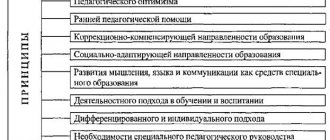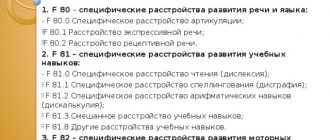The beginning of school life for every child is associated with many difficulties and experiences. At the same time, for some students, learning in the lower grades can be significantly complicated by the presence of special problems with writing and reading. And the point here is not laziness, lack of intelligence or unwillingness to learn. Many children, despite their full intellectual development, cannot master these skills even if they want to. In this case, experts talk about special disorders - dysgraphia and dyslexia.
Dysgraphia and dyslexia – what are they?
A specific impairment of written language is called dysgraphia. Children with this disorder experience serious difficulty writing letters and words, make a significant number of grammatical errors, and cannot correctly display written signs and symbols. No matter how hard they try, their handwriting remains uneven and sloppy, and tasks are completed slowly and with great difficulty. In the absence of a competent approach to such students, in the future this can develop into psychological problems, the development of self-doubt, isolation and depression.
Since writing and reading are interconnected components of one mental process, dysgraphia is very often accompanied by dyslexia. This pathology is associated with the child’s inability to master reading skills. In the presence of such a violation, the student skips or adds extra letters, initial syllables or words, distorts the correct sound of words and reads extremely slowly.
If dysgraphia is diagnosed in almost 25-30% of primary schoolchildren, then dyslexia occurs in approximately 8-10% of students. Disorders can occur both in pairs and independently of each other. As a rule, the first signs of disorders appear between the ages of 6 and 8 years. Pathologies require competent intervention by a speech therapist-speech pathologist, since their uncontrolled progression can be accompanied by dizziness, headaches, and a general deterioration in the child’s physical and psychological condition.
Benefits of Dyslexia
For the species Homo sapiens, reading is a relatively recent invention (it appeared along with writing around the 4th millennium BC). During this lesson, our thinking “switches” to a special operating mode. If adults who are far from literature are taught to read, their brains change in a special way. This is shown by the research of Stanislav Diana, a famous French neuroscientist. During the experiment, subjects lost
ability to process certain types of visual information - for example, they became worse at perceiving faces and chessboards.
The skill of reading competes with our other skills, that is, it has its price: you are strong in either one or the other.
The famous artist Maritz Escher is the author of numerous visual paradoxes. He depicted “impossible figures”—three-dimensional objects that are an optical illusion and cannot exist in reality. His famous lithograph "Waterfall", for example, has the structure of a Penrose triangle.
A group of psychologists studied people's ability to recognize such figures. It turned out that dyslexics did much better than others. The researchers hypothesized that this is because they tend to process visual-spatial information not locally (piece by piece), but rather holistically.
So there is a fair amount of truth to the myths that portray people with learning disabilities in a favorable light. For example, there is a rumor on the English-language Internet that more than 50% of NASA employees are dyslexic. “Not true,” NASA tweeted, “but they [dyslexics] are super smart.”
People who have trouble reading actually have some “trump cards” in sciences such as astrophysics.
Researchers have found a link between this disorder and the ability to process information useful in astronomy. For example, dyslexics have outperformed others at finding black holes!
In another study, the authors compared students' ability to remember blurry images that looked like X-rays—and dyslexics again excelled. So their talents can be useful in medicine and in many other fields.
Richard Rogers, the famous architect and one of the creators of the Pompidou Center, is dyslexic. By his own admission, he could not read until the age of 11, and was unable to learn poetry or do homework. They called him stupid. Even as a child, Rogers wanted to throw himself off a roof.
“Dyslexia, however, helped me realize that when people said, 'You're not
you can do it!“ - it was not worth paying attention.
“I don’t take ‘ no
’ too seriously,” Richard said.
He believes that dyslexia allows you to take a broader view of things, forget the “normal” ways of working and turn everything upside down.
The attention of people with a reading disorder is indeed distributed wider than the “norm”. For example, at a cocktail party, a “regular” person will focus on “central” sounds, while a dyslexic person will focus on those in the periphery.
Although the issue has not been sufficiently studied, it is clear that this disorder is associated with features in the functioning of the brain: dyslexia allows you to better see the picture as a whole, rather than in particular, to discover something exceptional and non-trivial, rather than banal and lying on the surface.
Therefore, such people are more likely to think outside the box. American professor Thomas West explains in his book that “out-of-the-box thinking” has always distinguished dyslexics.
When we call some features a disorder, we must remember that this definition is conditional. The same trait can be both a “violation” and an advantage – it all depends on the context and specific tasks. Dyslexia did not prevent molecular biologist Carol Greider and biophysicist Jacques Duboche from becoming Nobel Prize laureates. So no one should feel limited in their studies or career.
Many “disorders” are a normal part of neurodiversity. Our characteristics and differences serve as the driving force of progress, and if everyone had the same brains, humanity would stop in its development.
People are different - and society needs each of them.
Why do dysgraphia and dyslexia occur?
Despite the significant work done by specialists in studying this issue, today the reliable causes of the development of dysgraphia and dyslexia remain not fully understood. However, some information is still available. According to scientists, writing and reading disorders can occur as a result of:
- hereditary and genetic predisposition;
- improper development of the brain at various stages of growth;
- imbalance between the cerebral hemispheres;
- pathologies that occur during pregnancy or fetal injuries;
- development of somatic diseases;
- infections affecting the nervous system;
- presence of functional hearing or vision impairment;
- insufficient work on the child’s intellectual development;
- the presence of speech defects, incorrect pronunciation of sounds and words;
- small number of speech contacts;
- improperly formed visual analysis skills;
- teaching writing and reading skills too early in the absence of a child’s psychological readiness for this;
- excessive demands on the child, incorrect pace and teaching methods.
System of speech therapy work to overcome dysgraphia in primary schoolchildren
The relevance of the problem of studying and overcoming writing impairments in junior schoolchildren in secondary schools is increasing every year. This is explained by the increase in the number of children with dysgraphia, the breadth and prevalence of writing disorders in the population.
A neuropsychological approach to diagnosing writing skills and methods for preventing difficulties in mastering writing are presented in the works of T.V. Akhutina, N.M. Pylaeva, T.Yu. Khotyleva [1]. We find the diagnostic aspect of the problem of writing disorders in the works of N.L. Belopolskaya [2], who proposed an express method for determining the reading, counting and writing skills of children at the time of admission to school. R.I. Lalaeva and L.V. Venediktova [10] developed a method for diagnosing reading and writing disorders in primary schoolchildren. The correctional aspect of the problem of overcoming writing impairments is presented in the works of I.N. Sadovnikova [13], O.B. Inshakova [6], A.V. Yastrebova [18], etc.
The diverse views of scientists on the etiology of writing disorders and original works devoted to the study and correction of writing disorders arouse increased interest in this problem, and also determine its significance.
Problems of studying writing skills are considered by representatives of different scientific schools. Many of them point to the difficulties of forming this process in younger schoolchildren, because The psychological process of mastering writing is quite complex, which is impossible without the following operations: writing intent, selection of lexical and grammatical units, phonological analysis of words, translation of phoneme into grapheme, grapheme into kineme, control (comparison with intent).
Examinations of children with writing deficiencies show that among them there are often children with oral speech disorders. Writing disorders may be based on insufficient development of all components of speech, both phonetic-phonemic and lexical-grammatical. Depending on the degree of development of the analysis of the phonological composition of a word in children with speech impediments, the following levels of mastery of writing skills are distinguished: from unformed to relatively well developed with specific errors.
The history of studying disorders of the writing process represents the views of different researchers, both in Russia and abroad. Writing disorders were first mentioned at the end of the 19th century. In 1937 O. Orton described reading, writing and speech disorders in children.
In 1914 N.K. Monakov [4] considered the cause of writing disorders to be a violation of the structure and functions of one of the analyzers that ensure the writing process. Domestic psychologists R.A. Tkachev and S.S. Mnukhin [4] in the 30s of the 20th century associated writing impairments with a violation of mnestic processes. Representatives of domestic speech therapy, its pedagogical direction, R.E. Levin [11], L.F. Spirova [14], R.I. Lalaev [10] in the 60s explained writing impairments as a consequence of oral speech impairments. Writing disorders are based on either phonetic-phonemic disorders or general speech underdevelopment. A.N. Kornev [7] presented a multiaxial approach to the problem of writing impairment in children.
Currently, there are quite a lot of classifications that describe various writing disorders.
One of them is the classification of O.A. Tokareva [4]. In line with the etiopathogenetic approach (based on the lesion of the cerebral cortex), the following forms of dysgraphia are distinguished: motor afferent kinesthetic dysgraphia, motor efferent kinetic dysgraphia, acoustic dysgraphia, optical dysgraphia.
In motor afferent kinesthetic dysgraphia, the lesion affects the inferior parietal parts of the cerebral cortex. As a result, errors arise associated with insufficient kinesthetic sensations about the position of the organs of articulation at the moment of pronunciation of sounds during internal pronunciation during the writing process. With motor kinetic dysgraphia, the inferior frontal parts of the cerebral cortex, which provide regulation and control of writing skills, are affected. There are omissions, rearrangements, additions, fusions of speech units: syllables, words, sentences. Acoustic errors are associated with a violation of phonemic perception, speech-auditory memory, and difficulties in differentiating phonemes by acoustic parameters. In writing, this manifests itself in the form of substitutions or mixtures. Optical dysgraphia is a consequence of unformed visual-spatial concepts, visual perception, visual memory and manifests itself in the substitution of letters that are similar in spelling.
In the practice of speech therapy work, a symptomatic classification of writing disorders is used, developed by leading professors of Russian speech therapy L.S. Volkova and R.I. Lalaeva [4].
The presented 5 forms of dysgraphia are either a consequence of unformed oral speech, or a manifestation of immaturity of optical-spatial concepts. Among younger schoolchildren with writing problems, the most common problems are: phonemic dysgraphia, caused by a violation of phonemic perception; agrammatic dysgraphia, which is based on agrammatism of oral speech; dysgraphia of language analysis and synthesis, in which the child does not differentiate the concepts of sentence, word, syllable and letter. Articulatory-acoustic dysgraphia is associated with a violation of the pronunciation of sounds in the native language, while the child writes the way he pronounces the sounds. Optical dysgraphia manifests itself to a greater extent in children with mental retardation, less often in children with general speech underdevelopment; errors are associated with a violation of optical-spatial concepts.
A.N. Kornev [7] proposes the author’s approach to creating a classification of writing disorders in children. According to the modern multiaxial classification he developed, all difficulties in mastering writing are divided into 2 large groups: dysgraphia and dysorthography. Dysgraphia can be true or false. False dysgraphia is caused by the child’s inability to attend classes to develop writing skills (as a result of serious chronic diseases), incorrectly selected methods for developing writing, and the presence of pronounced disturbances in the activity of the analytical systems. True dysgraphia was divided into two groups - dysphonological, caused by a violation of phonemic processes, and metalinguistic, caused by the immaturity of higher mental functions that provide the functional basis of writing.
Many scientists and researchers in their works define dysgraphia as a condition, the main manifestation of which is a persistent selective inability to master the skill of writing, despite a sufficient level of intellectual and speech development for this, the absence of disorders of the auditory and visual analyzers and optimal learning conditions.
The causes of such disorders are various external and internal harmful factors affecting the activity of the central nervous system: hereditary (constitutional) predisposition, diffuse or local lesions of those areas of the cortex that provide writing skills as a result of exposure to hypoxic, infectious, toxicological or traumatic factors; unformed interhemispheric interaction; incorrectly selected methods of teaching writing.
Difficulties in mastering writing skills arise as a result of a combination of three groups of phenomena:
- biological failure of certain brain systems;
- functional failure of the central nervous system;
- environmental conditions that place increased demands on developmentally delayed or immature mental functions.
Difficulties in mastering writing are observed in primary schoolchildren with various disorders of speech, higher mental functions, intelligence, as well as in relatively healthy children.
First of all, writing is impaired in children with intellectual disabilities, and the severity of dysgraphia correlates with the level of intellectual activity. Dysgraphia manifests itself in children with low vision and blindness, hard of hearing and deaf children, in children with mental retardation, and in children with musculoskeletal disorders.
Dysgraphia can be observed in children with speech disorders. The degree of severity varies: from complete inability to write (with alalia, anarthria) to individual specific errors in writing. Not all speech disorders can cause dysgraphia. Usually this disorder is not observed in rhinophonia, aphonia, and dysphonia. Early correctional work of a speech therapist with children of senior preschool age in speech therapy groups helps prevent the occurrence of dysgraphia. Children with persistent writing impairments are taught in a Type V school for children with severe speech impairments; children with mild speech impairments can be educated in a comprehensive school at a speech therapy center. Children with phonetic-phonemic disorders have phonemic digraphia, and children with general speech underdevelopment have several forms of dysgraphia, primarily agrammatic and language analysis and synthesis. Children with general speech underdevelopment master basic writing skills, but make a large number of errors due to a violation of grammatical structure. They spell the endings of words incorrectly and often ignore prepositions.
To organize speech therapy work, it is necessary to conduct a speech therapy examination to identify writing difficulties in younger schoolchildren.
To examine writing skills, the following basic techniques are used: writing specially selected texts, writing individual letters, writing words of different syllabic structures. At the same time, 2 types of work are offered - copying and handwritten or printed text and taking dictation. A survey of oral speech and writing skills is presented in the works of I.N. Sadovnikova [13], T.A. Fotekova [16], T.P. Bessonova and Gribova O.E. [3], Yastrebova A.V. [17] and others.
In our study, we studied the writing characteristics of second-grade students of secondary schools attending a speech therapy center. A survey of the written work of junior schoolchildren was carried out in secondary schools in the Eastern District of Moscow in September 2012. The experiment involved 75 second-graders aged 8 to 9 years. All children had intact intelligence and good physical hearing. Upon entering school, all students had a specialist opinion on normal neuropsychic and physical development. 16% of schoolchildren did not have oral speech disorders, but had previously attended speech therapy groups for children with physical impairment or speech impairment. 84% of children had oral speech disorders. Of these, 7 children had a phonetic disorder, 25 had FFN, 3 schoolchildren had third-level ODD, and 28 had fourth-level ODD. For all students, Russian was their native language.
All children, according to primary school teachers, had writing impairments that were not limited to errors on spelling rules.
The examination of writing skills was carried out according to the methodological recommendations of I.N. Sadovnikova [13], which is traditional in practical speech therapy. The survey results were as follows:
— two children showed articulatory-acoustic dysgraphia (these are children with phonetic disorders);
— 17 children had phonemic dysgraphia (8 children with FFN and 9 children with OHP);
— 12 children with ODD showed agrammatic dysgraphia;
— 7 children have dysgraphia of language analysis and synthesis,
— optical dysgraphia was observed in 13 children.
Based on the results of the study, we developed the main directions of speech therapy work to overcome dysgraphic errors. This work is based on the methodological recommendations of A.V. Yastrebova [18] and presents the system of work of a teacher-speech therapist at a speech center in a secondary school.
The organization of the work of a teacher-speech therapist at a speech center of a general education school is determined by the methodological letter of the Ministry of Education of the Russian Federation. At the speech center, a teacher-speech therapist works at a time when children are free from basic lessons in the educational program; he conducts classes with younger schoolchildren who have speech disorders. Corrective training is planned by periods. The speech therapist draws up a long-term plan in two versions: for 1st grade students (mastering writing) and for 2nd - 4th grade students (writing). Children study in subgroups; only in cases of severe disorders (stuttering, rhinolalia) individual work is expected. Children with speech disorders are enrolled in the speech center: phonetic speech underdevelopment; phonemic speech underdevelopment; FFN; OHP level 4; OHP level 3; stuttering not complicated by FFN or OHP; postoperative rhinolalia.
The speech therapist maintains the following types of documentation: speech cards for each child, individual notebooks for developing pronunciation and writing, a long-term calendar plan of work, individual student cards and a report on work effectiveness.
The main principles of speech therapy work are the principles of complexity and consistency, the principle of taking into account pathogenesis, the principle of taking into account the psychological structure of the reading process, the principle of maximum reliance on multimodal afferentations, the principle of the gradual formation of mental actions and didactic principles of teaching.
The principle of an integrated approach involves simultaneous work on the development of oral speech, reading and writing. Currently, dysgraphia is considered as a language disorder, that is, a disorder caused by the underdevelopment of linguistic generalizations. The mechanisms that cause dysgraphia simultaneously cause oral language impairment and reading impairment. In this regard, when eliminating dysgraphia, speech therapy influences the entire complex of speech disorders.
The principle of consistency is based on a methodology for eliminating each type of disorder, which is a system of methods aimed at overcoming the main defect and creating a specific functional system. The use of each method is determined by the main purpose and its place in the overall system of work.
The principle of accounting for pathogenesis involves taking into account the causes and mechanism of disorders. In many cases, disorders with identical symptoms have different mechanisms. Thus, letter substitutions are observed in various forms of dysgraphia. In optical dysgraphia, they are associated with underdevelopment of visual gnosis; in phonemic dysgraphia, they are associated with insufficient phonemic perception. In each of these cases, the working methodology will be different, because should be aimed at overcoming the underlying mechanism of the disorder.
The principle of taking into account the psychological structure of the writing process takes into account broken links or operations. In children with writing impairments, a different mechanism of disorganization is found: unformedness of one of the operations, unformedness of several operations, insufficient automation, disruption of the integral program of activity while individual operations are formed. When correcting dysgraphia in the process of work, the teacher-speech therapist forms mental actions in the child and brings them to automatism.
The principle of maximum reliance on multimodal afferentations (reliance on various analyzers) is based on the idea of speech as a complex functional system; when some are underdeveloped, reliance is placed on other intact links.
The principle of the gradual formation of mental actions was described in detail by P.Ya. Galperin [5]. He identified the main stages of the formation of mental actions: drawing up a preliminary idea of the task; mastering action with objects (the stage of materialization of action on the external plane); stage of action in terms of loud speech; transferring action to the mental plane; the final formation of mental actions. In the process of speech therapy work, a gradual internalization of the action occurs (sound analysis: chips, diagrams; auditory and pronunciation images of words; according to ideas).
Didactic principles include the principle of taking into account the zone of proximal development, the principle of gradually increasing the complexity of tasks and speech material, the principle of taking into account symptoms and severity, the principle of the activity approach, and the ontogenetic principle.
The main tasks of overcoming dysgraphia are: overcoming dysgraphic errors in writing and the formation of voluntary control in the process of performing written work.
When correcting optical dysgraphia, exercises are proposed to develop visual perception and recognition (visual gnosis), to clarify and expand the volume of visual memory; on the formation of spatial perception and ideas; on the development of visual analysis and synthesis; to differentiate mixed letters.
In case of articulatory-acoustic and phonemic dysgraphia, the tasks of speech therapy work are the production of sounds and clarification of their articulation, the development of phonemic hearing, and the development of the sound composition of the word. The main methods and techniques are: a) distinguishing between vowels and consonants; b) isolating any sounds from a word; c) combining sounds into syllables; d) combining syllables into words; e) determining the sequence of sounds in a word.
When correcting agrammatic dysgraphia, the task of speech therapy work is to overcome agrammatisms in oral speech. In subgroup classes, the teacher-speech therapist develops word formation and inflection skills. The main attention is paid to the ability to use the categories of gender, number, case, and the correct use of prepositions in speech.
When correcting dysgraphia of language analysis and synthesis, a speech therapist teaches to distinguish between the concepts of “sentence”, “word”, “syllable”, “sound”, to model various types of phrases and sentences using analogies, to select suitable sentences for given schemes, and to determine the number of words in a sentence.
To develop voluntary attention when overcoming dysgraphia, tasks are proposed that are used when examining voluntary attention, as well as exercises from the methodological recommendations of N.A. Tugova [15], developed for the development of voluntary attention of primary schoolchildren in logorhythmic classes.
Exercises for switching attention are associated with the transition from one movement to another in accordance with a change in musical accompaniment. At first, only 2 movements and 2 musical fragments are offered, then the number of movements reaches 5 - 6.
Exercises for switching attention alternate with exercises for its stability. For example, walking to music is suggested, followed by counting steps without musical accompaniment, or exercises consisting of several movements are given. The latter first include 2 movements, then the number of movements is increased to 5 - 6.
Exercises to expand attention span are more complex and are carried out later. For example, 2 children from a class simultaneously show the simplest movements, the third must reproduce them sequentially.
Exercises for the distribution of attention involve the simultaneous performance of 2 or several actions. For example, schoolchildren walk in a circle to marching music, simultaneously beating the rhythm of the melody with their palms.
Particular attention is paid to musical and motor games, where all the basic qualities of voluntary attention are developed, so necessary for the formation of educational activities in primary school. These exercises and games can be carried out not only during rhythm classes, but also when organizing dynamic pauses during lessons.
The practice of speech therapy work shows that the development of voluntary attention of younger schoolchildren is carried out mainly in speech therapy classes. The possibility of developing attention in other types of activities (in logarithmic classes or in individual work), which contributes to the development of volition, composure, confidence, helps to overcome writing impairments, and prepares children for studying in secondary school, is limited by the lack of specialists. It is rare that any school (perhaps except private ones) has a position for a teacher of speech therapy rhythms or conditions for conducting such classes by a teacher - speech therapist.
One of the important tasks of speech therapy work is not only to overcome writing disorders, but also to prevent their occurrence in preschool children, especially in children with impaired sound pronunciation. A study by employees of the speech therapy sector of the Institute of Defectology of the Academy of Pedagogical Sciences of the Russian Federation showed that difficulties in learning to read and write do not arise in all children with pronunciation deficiencies, but only in those whose pronunciation deficiencies are an indicator of incomplete phoneme formation. L.F. Spirova [14] examined children with correct speech and with FFN upon entering school and found that: the isolation of vowels at the beginning of a word is available in 78% of children with normal speech and in 46.2% of children with FFN. Isolation of consonants at the beginning of a word is available to 53% of children with normal pronunciation and 18% of children with FFN. Isolation of the vowel in the middle is available to 20% of children with normal speech and only 3% of children with FFF.
To prevent the occurrence of dysgraphia in primary schoolchildren, a certain level of speech training is required, which is ensured by a special system of classes on the development of grammatical structure, the accumulation and refinement of vocabulary and the formation of pronunciation.
In the process of mastering literacy, the sound and letter composition of words is first studied. Observation of the sound composition of a word, comparison and juxtaposition of similar and different features, logical exercises in analysis and synthesis contribute to the formation in children of clear and clear ideas about the sound composition of a word, which leads to the formation of correct pronunciation and teaches them to consciously read and write.
When teaching literacy to children with speech impairments, the following conditions are taken into account:
— training is conducted only on correctly pronounced sounds and words (learning to read and write is built as a continuation of learning pronunciation);
- a special order for studying sounds and letters is proposed: a u o m x p k s n v y t l sh r zh, soft phonemes, th, soft, voiced consonants, affricates;
— the pace of passage of all sounds is slower;
- when working with a split alphabet, the skill of quick orientation in the sound and letter composition of a word is formed;
— in-depth work is carried out on the formation of morphological generalizations;
- speech material is systematically repeated and reinforced;
- children are gradually introduced to the basic rules of grammar and spelling.
At the present stage of development of domestic speech therapy, there are a number of social problems related to overcoming writing disorders in primary schoolchildren. There is no system for selecting children at risk for possible manifestations of dysgraphia in the future. The selection of children is carried out only by speech therapists and covers those children who attended speech therapy groups in kindergarten. Prevention of writing disorders is poorly organized and applies mainly to children with oral speech disorders. Overcoming diagraphia in children is carried out only by speech therapy methods; neuropsychological technologies are practically not used. Organizational forms for the correction of dysgraphia in younger schoolchildren have not been developed: there are no special classes or groups for children with dysgraphia.
It is possible that the conditions of inclusive education, when children with difficulties, problems and disabilities will study together with normally developing peers, will attract many other specialists working at school to the issue of overcoming writing disorders in primary schoolchildren.
Literature:
- Akhutina T.V., Pylaeva N.M., Khotyleva T.Yu. Neuropsychological approach in inclusive education. Inclusive education: methodology, practice, technology: Proceedings of the international scientific and practical conference (June 20-22, 2011, Moscow). M., MGPPU, 2011.
- Belopolskaya N.L. Express method for testing reading, counting and writing skills. M., Kogito-center, 2013
- Bessonova T.P., Gribova O.E. Didactic material on examining children's speech. Part II: Vocabulary and grammatical structure. M., ARKTI, 1997.
- Volkova L.S., Shakhovskaya S.N. Speech therapy. Textbook for students of defectology. fak. ped. Universities. M., 1998.
- Galperin P.Ya. Psychology of thinking and the doctrine of the gradual formation of mental actions. M., 1966.
- Inshakova O.B. Development and correction of grapho-motor skills in children 5-7 years old. Manual for speech therapist. Set in 2 parts. M., Vlados, 2013.
- Kornev A.N. Reading and writing disorders in children. St. Petersburg, 2003.
- Kornev A.N. Preparing for literacy training for children with speech impairments. Moscow, 2007.
- Correction of written speech. / Ed. Yakovleva A.V. St. Petersburg, 2003
- Lalaeva R.I., Venediktova L.V. Diagnosis and correction of reading and writing disorders in primary schoolchildren: Educational and methodological manual. St. Petersburg, 2003.
- Levina R.E. On the genesis of writing impairments in children with general speech underdevelopment. Questions of speech therapy. 1959.
- Speech therapy at school: Practical experience. / Edited by V.S. Kukushina. Rostov-on-Don, 2010.
- Sadovnikova I.N. Dysgraphia, dyslexia: technology of overcoming. Moscow, 2011.
- Spirova L.F. Features of sound analysis of children with speech impediments. Textbook edited by R. E. Levina. Moscow. Publishing house of the Academy of Pedagogical Sciences of the RSFSR, 1957.
- Tugova N.A. Raising attention in children who stutter during rhythm lessons. - and. Defectology No. 6, 1970, pp. 60-63.
- Fotekova T.A. Test methodology for express diagnostics of oral speech of primary schoolchildren. M., 2002.
- Yastrebova A.V., Bessonova T.P. Identification of deficiencies in oral and written speech in primary school students. / Fundamentals of speech therapy work with children. - Moscow, 2003.
- Yastrebova A.V., Bessonova T.P. Contents and methods of correcting deficiencies in oral and written speech in primary school students. / Fundamentals of speech therapy work with children. - Moscow, 2003.
Who is at risk for developing dysgraphia and dyslexia?
The possibility of developing these pathologies is significantly higher in those children who:
- do not pronounce sounds clearly, articulate sluggishly;
- have general speech underdevelopment and have not attended speech therapy classes;
- write with the left hand or write with the right after they have been retrained;
- grow up in families where they speak different languages;
- start learning to write and read too early;
- went to school early and immediately started learning a foreign language;
- have attention deficit disorder, hyperactivity disorder or mental retardation.
How to help a child with dysgraphia or dyslexia?
Parents will not be able to cope with this problem on their own. In such situations, it is necessary to contact a qualified speech therapist-defectologist. Disorders can be corrected, but the effect of working with a specialist will largely depend on the timely detection of the problem. With the right approach, a child who has such defects identified before starting school will reach the norm in 80-85% of cases. When dysgraphia or dyslexia is detected in grades 1-2, success is visible in 70% of students. If parents turn to a specialist when the student has already completed primary school, only in 35-40% of cases the specialist manages to normalize reading and writing skills. In other cases, long courses of classes are required to achieve the norm.
The key goal of classes with a speech therapist is for the child to acquire information about how sounds are pronounced correctly and how they are reflected in writing. For this purpose, various speech games are used, and a visual visualization system is also used.
In this case, close cooperation between the speech therapist and parents is extremely important. Deficiencies caused by dysgraphia and dyslexia should be eliminated not only in speech therapy classes, but also at home. Only comprehensive work to correct them will achieve positive results.
Publication date: 03/04/2019. Last modified: 01/13/2020.
Diagnostics
In Western countries, a child suspected of having dyslexia or dysgraphia may be referred to a school psychologist, neurologist, or regular pediatrician. In Russia, most specialists are not trained to work with such problems, but here you can also find psychologists, neuropsychologists and neurophysiologists who deal with this issue.
“It’s better to identify symptoms early. It’s good if the child is diagnosed by a neuropsychologist before going to school. Learning disorders are predictable. If we examine a person at the age of 6, we will be able to predict his problems at school,” says Irina Pasechnik.









